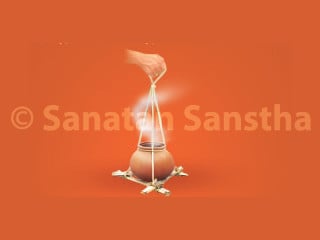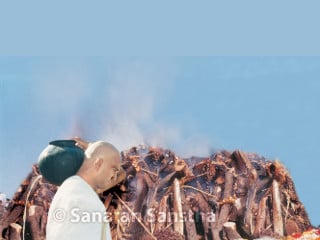1. Rituals to be performed on the same day after cremation
A. Method according to the Scriptures
-
Immediately after cremation, bathe by taking a dip in a river, lake or with well water while chanting continuously.
-
For offering tilānjali (Offering sesame seeds [til] and water), the kartā should place some black sesame in a pot containing water. Then the kartā, the family members and other relatives & friends should offer this water containing black sesame thrice on the ashma along the pitru-tīrtha (Area of the palm between the thumb and the index finger portion) of their palms while uttering ‘एष ते तिलतोयाञ्जलिस्तवोपतिष्ठताम्’,
Meaning ‘tilānjali is being offered unto you’ while mentioning the gotra (Lineage according to Vedic science) and the name of the deceased. One whose father is alive should not offer tilānjali.
-
After returning home, keep the ashma in the area around the tulsī-vrundāvan (A small rectangular structure in which tulsī [Holy basil] is grown), but not besides the tulsī If tulsī-vrundāvan is not available, then keep the ashma outside the house in a safe place.
-
Bite a neem leaf before entering the house. Then perform āchman (Sipping water from the palm), touch Holy items like fire, water, cow-dung, white mustard etc. and then step on a stone (Step made of stone) before finally entering the house slowly.
-
In some neighbouring house, prepare a food item called ‘pithalē-bhāt’ (pithalē – a sauce like gravy made from gram flour boiled and spiced; bhāt – plain white cooked rice) for meals and bring it to the house of the deceased. Take a small portion of this on a leaf (preferably a banana leaf) and place it outside the house as naivēdya (Food offered to the Deity as part of ritualistic worship) for Vāstudēvtā (Presiding Deity of the house) and Sthāndēvatā (Presiding Deity of the area). The remaining food is to be offered to the Ishtadēvatā (Benevolent Deity) and then consumed by all.
B. Method to be followed if it is not possible to bathe outside, as mentioned in the Scriptures
-
On returning home after cremation, place ashma in the area around tulsī-vrundāvan; but not inside the tulsī-vrundāvan. If tulsī-vrundāvan is not there, place it somewhere safe outside the house.
-
Before entering the house, purify yourself by sprinkling gomutra (Cow’s urine) all over your body.
-
Bite a neem leaf and enter the house slowly. Repeat this action as mentioned earlier.
-
Remember to keep chanting while taking a bath.
-
Offer tilānjali as mentioned above.
-
Prepare in a neighbouring house ‘pithalē-bhāt’ and partake of that. Repeat this action as mentioned earlier.
2. Immersion of asthī (Bones of the deceased)
The asthī (bones of the deceased) are collected either on the day of cremation or on the 3rd, 7th or 9th day and are immersed in flowing water before the 10th day. It is better to collect asthi on the 3rd day following cremation rites. If asthī are to be immersed after the 10th day then it should be done only after performance of the ritual of tīrtha-shrāddha.
3. Pinḍadān
According to the science of rituals, rites such as tilānjali and pinḍadān (Ritual of offering of rice balls) should be performed beginning from 1st day till the 10th day. Visham shrāddha should be performed on odd days. If that is not possible then uttar-kriya should begin from at least the ninth day. Nowadays, however, pinḍadān that should be performed from 1st day to 10th day is performed as a combined ritual on the 10th day. On 10th day, pinḍadān is performed in a Shiva temple or in a temple of an inferior Deity situated on the bank of a river.
After the pinḍadān on the 10th day, a little coconut oil is poured on the ashma and it is immersed in flowing water.
3. Acts to be performed on 11th and 12th day
On the 11th day, panchagavya hom (Fire-sacrifice to appease Deities) should be performed in the house and panchagavya (A mixture of cow’s milk, curd, ghee, cow’s urine and cow dung) should be sprinkled all over the house. All family members should sip panchagavya. The kartā should make a sankalp (resolve) for the benefit of the deceased and donate food-grains and perfom dasha-dāns (Ten types of donations or offerings). Shrāddhas (Special rituals performed for the departed ancestors) such as Ekoddishta shrāddha, Vasugan shrāddha and Rudragan shrāddha should be performed outside the house, in a cowshed or elsewhere.
A. Sapindikaran shrāddha : Sixteen monthly shraddhas are performed on 11th or 12th day so that one becomes authorised to perform sapindikaran shrāddha. Sapindikaran shrāddha is performed on the 12th day. With the performance of sapindikaran shraddha, the individual attains the title of ‘Pitru’ and gets a place in Pitrulok. Really speaking, it is appropriate to perform sixteen monthly shrāddhas in the respective months and sapindikaran shrāddha a day before the yearly shrāddha; however, the present custom is to perform all this on the 12th day post-death itself.
5. The ritual of Nidhanshānti (Shānto-dak)
On the 13th day, Pathēya shrāddha is performed and ritual of Nidhanshanti is performed. All the near and dear ones should be invited and served a sweet meal. In today’s times, this ritual is performed on the 12th day itself.
6. Inviting everyone on the 13th day for a meal comprising sweets
Due to the rituals performed on the 13th day, the linga-dēha (subtle body) penetrates the atmospheric range of earth and attains further momentum. Attaining momentum means cutting off all ties with his family members by the linga-dēha and developing a relationship with God. To greet this blissful process of doing away with the attachment with the gross body and developing attraction towards God, everyone is invited for a meal comprising sweets as a symbolic gesture.
Reference : Sanatan’s Holy Text, ‘Death and post-death rites’


 Rituals to be performed prior to and during cremation of a dead body
Rituals to be performed prior to and during cremation of a dead body In which direction should the dead body be placed before taking it to the crematorium ?
In which direction should the dead body be placed before taking it to the crematorium ? Rituals after death as per Hinduism
Rituals after death as per Hinduism